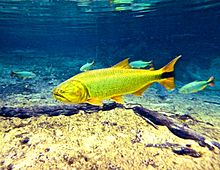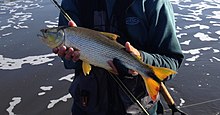| Dorado | |
|---|---|

| |

| |
| Conservation status | |
 Least Concern (IUCN 3.1) | |
| Scientific classification | |
| Domain: | Eukaryota |
| Kingdom: | Animalia |
| Phylum: | Chordata |
| Class: | Actinopterygii |
| Order: | Characiformes |
| Family: | Characidae |
| Genus: | Salminus |
| Species: | S. brasiliensis |
| Binomial name | |
| Salminus brasiliensis (G. Cuvier, 1816) | |
| Synonyms | |
|
Salminus cuvieri Valenciennes, 1850 | |
Salminus brasiliensis, also known as the golden dorado, dorado, river tiger, dourado, or jaw characin is a large, predatory characiform freshwater fish found in central and east-central South America. Despite having Salminus in its name, the dorado is not related to any species of salmon, nor to the saltwater fish also called dorado. It is very popular among recreational anglers and supports large commercial fisheries.
Name
Dorado, both in the name of the fish and other uses such as the El Dorado legend, originates from the Latin word for gold, auratus (later modified into dauratus in Vulgar Latin, and subsequently oro in Italian and Spanish, and ouro in Portuguese).
The Portuguese word dourado and Spanish dorado both mean 'golden' and is applied to the fish due to its color displaying golden reflections.
Description
The golden dorado has a large head, with powerful jaws filled with sharp teeth. Adults are yellow-golden in color, but juveniles are more silvery. Immatures (to a lesser extent adults) resemble Brycon hilarii and Salminus hilarii. It reaches maturity around 37 cm (15 in) long. The average size of the golden dorado is about 3–10 kg (6.6–22.0 lb). The largest recorded size is 1.3 m (51 in) in length and 34 kg (75 lb) in weight. Females grow considerably larger than males, but otherwise the sexes are similar. It is the largest scaled freshwater fish in the Río de la Plata Basin (the only fish that can surpass it in size are certain river stingrays and catfish; both scaleless).
Distribution, habitat and life cycle

The golden dorado is native to warm freshwater habitats in southern Brazil, Paraguay, Uruguay, Bolivia and northern Argentina. Here it inhabits the Paraguay (including the Pantanal), Paraná, Uruguay, Chapare, Mamoré and Guaporé River basins, and the drainage of the Lagoa dos Patos. Outside its native range, the golden dorado has been introduced to several southeast Brazilian river basins, notably Doce, Paraíba do Sul, Iguazu and Guaraguaçu.
Other South American river basins hold relatives of this species: S. franciscanus in the São Francisco Basin, S. hilarii in the upper Paraná, Amazon and Orinoco basins, and S. affinis in the Santiago and Magdalena basins in Ecuador and Colombia.
The golden dorado generally prefers water temperatures between 20 and 28 °C (68–82 °F). It is migratory in response to temperature, season and food sources, and moves upstream, typically about 400 km (250 mi), to spawn in the spring and summer. It is generally a solitary species, but migrates in groups. The females reach maturity when 4–5 years old and can lay up to 2 million eggs, which are released near the water surface. Golden dorados can reach an age of more than 15 years.
Diet

The golden dorado is the apex predator in its freshwater habitat. They are primarily piscivores, eating a wide variety of fish, but have also been recorded feeding on large insects, crustaceans and small vertebrates (for example, rodents, lizards and birds). One of the adult dorado's favorite prey is the streaked prochilod (Prochilodus lineatus), a species of schooling fish that also is migratory.
In the larval stage, golden dorados feed on plankton. As they grow larger, they switch to insects and small fish. At up to 30 cm (12 in) long, juveniles are aggressive mimics of Brycon hilarii in both general shape and color, often staying near schools of this frugivorous species to be able to surprise smaller prey fish such as Astyanax and Moenkhausia tetras. In contrast, adult dorados have been known to eat Brycon hilarii.
Status
The golden dorado has declined because of overfishing and dams, which restrict its breeding migration. It is listed as a threatened species in Rio Grande do Sul in Brazil and in Paraguay; in the latter country, a five-year fishing ban was put into effect.
In contrast, the golden dorado has been introduced for fishing to several rivers outside its native range. Being a large highly predatory species, this represents a serious threat to the native fish in these rivers.
Fishing
| This section includes a list of references, related reading, or external links, but its sources remain unclear because it lacks inline citations. Please help improve this section by introducing more precise citations. (November 2014) (Learn how and when to remove this message) |
| This section contains instructions, advice, or how-to content. Please help rewrite the content so that it is more encyclopedic or move it to Wikiversity, Wikibooks, or Wikivoyage. (November 2014) |

The golden dorado is highly sought-after by anglers, both for its meat and its fighting ability. From the 2000s onwards, the dorado has been increasingly recognized as a fly-fishing targeted species. Its aggressive behavior and initiative taking flies, paired with great fight energy, frequently going airborne in the attempt to loosen itself from the hook, make this species a true game fish.
This fish usually takes flies both on the surface and sub-surface; anglers tend to make use of heavier fly tackle (#6 and up, reaching #12 in some places) for placing bulky flies which are seen to be more attractive to the dorado.
Also often used by fly fishermen are intermediate and sinking-tip fly lines once the species feeds on fast currents. The dorado is an avid hunter but can be a lazy chaser. Anglers make use of either very slow or very fast movement of the flies to spark attacks by the dorado, depending on the region and season, denoting gregarious behavior and an ambush feeding strategy. It does not move after prey and attacks passing-by fish or reacts only when the prey make a deliberate attempt to escape.
Shiny, flashy material is very attractive to this fish, which led to the development of flies with much shiny, colorful material, or in opposition, dark or black ones, suggesting lesser visual accuracy of the species.
Fly fishermen use minnow-like flies, streamers and other fish-imitating flies, but the fish's preference for large flies that swim below the surface led to the creation of a specific pattern – the Andino Deceiver.

Due to the dorado's very sharp teeth, anglers use steel wire or fluorocarbon monofilament bite tippets to prevent the fish from cutting the line.
References
- IUCN (2020-10-07). Salminus brasiliensis: Frederico, R.G.: The IUCN Red List of Threatened Species 2023: e.T186400A1812492 (Report). International Union for Conservation of Nature. doi:10.2305/iucn.uk.2023-1.rlts.t186400a1812492.en.
- ^ Froese, Rainer; Pauly, Daniel (eds.). "Salminus brasiliensis". FishBase. February 2017 version.
- ^ Miles, P.A. (24 September 2014; updated 29 November 2016). Dorado. GlobalFlyFisher. Retrieved 28 February 2017.
- Lima, F. C. T., and H. A. Britski (2007). Salminus franciscanus, a new species from the rio São Francisco basin, Brazil (Ostariophysi: Characiformes: Characidae) Neotrop. Ichthyol. 5(3).
- ^ Pantanal Escapes: Dorado. Retrieved 28 February 2017.
- ^ Bessa, Carvalho, Sabino, and Tomazzelli (2011). Juveniles of the piscivorous dourado Salminus brasiliensis mimic the piraputanga Brycon hilarii as an alternative predation tactic. Neotrop. Ichthyol. 9(2).
- Fishing World-records: Salminus brasiliensis. Retrieved 25 February 2017.
- Ziegler, M.F. (29 April 2013). Estudo descobre 78 novas espécies de peixes no Rio Madeira. Ultimosegundo.com. Retrieved 28 February 2017.
- ^ Vitule, Bornatowski, Freire, and Abilhoa (2014). Extralimital introductions of Salminus brasiliensis (Cuvier, 1816) (Teleostei, Characidae) for sport fishing purposes: a growing challenge for the conservation of biodiversity in neotropical aquatic ecosystems. BioInvasions Records 3(4): 291–296. doi:10.3391/bir.2014.3.4.11
- Froese, Rainer; Pauly, Daniel (eds.). "Species in genus Salminus". FishBase. February 2017 version.
- Law Number 3191/07, Which prohibits the fishing, extraction, collecting and stocking for ulterior commercialization of the species Salminus maxillosus, of common name Dorado fish. Archived 2011-10-04 at the Wayback Machine (MS Word Document) (In Spanish). Retrieved on 20 November 2010.
| Taxon identifiers | |
|---|---|
| Salminus brasiliensis | |